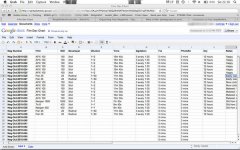I'll lift this quote and my reply from an earlier thread, which explains my system. There's a lot of different approaches to this!
🙂
Hi all;
I'm considering changing the way in which I store my 35mm B/W negatives.
Currently they reside in 3-ring binders, in Print-File type sleeves, where the negatives are in strips of 5-6 images each. It seems the most efficient way to organize and label them using this old system is chronologically, since one sheet represents a complete roll of film.
The problem I have with the current system is 1) locating individual negatives and 2) having to risk scratching the 'neighboring' images when removing a strip of film to print or scan just one negative.
I've thought that perhaps mounting each individual negative in its own slide mount might be a better way to go, as they could be organized in 'random access' order, ran than serial order; and they could also be cataloged in slide storage boxes by other criteria than just chronology (such as subject matter, etc.) I'm also concerned about possible scratches to the negs when pulling them in/out of the plastic storage sleeves, thinking therefore that slide mount storage could be better. Also, getting a slide mount negative carrier for my enlarger would simplify the handling of each negative when wet printing, reducing the risk of scratching the image or damaging neighboring images in a strip.
What thinks ye? Have you done this, or considered doing this, yourself?
~Joe
You don't need to do that to achieve the ability to locate an individual negative. You have already mentioned the word catalog, which refers to setting up an "intellectual access" system that links to a physical storage system. That is the key.
First, each negative is assigned a code that describes and controls the physical arrangement and storage of the negatives. In my case I number all rolls serially, and negatives within the roll serially. My most recent roll is therefore coded BW147, and the negatives are numbered _n, so the 10th negative is fully described as BW147_10. Like you, my negatives are stored in plastic sheets held in binders, all in numerical sequence.
To locate a particular image requires a catalog. Library book catalogs are typically for Author/Title, and for Subject Headings. This gives you three access points - the name of the author, the title of the book, and the subject headings (which are assigned from a controlled list of headings - a thesaurus). With modern technology we also have access via free-text keywords (your typical google search).
For my negatves I assign keywords (subject headings) from a growing list, which describe the technical attributes (camera. lens, film, developing), locations, persons, and the subject matter (eg cloud, tree, architecture, etc). I try to be generous and describe the content of each image with enough keywords to achieve both exhaustivity (describe all aspects of the image content) and specificity (describe the specific content of the image).
The software I use allows me to search by each of these keywords, and logical combinations of keywords (eg camera type = "Leica M4" AND Location = "Darling Harbour").
I actually use Adobe Lightroom as my catalog, and I think this is its most powerful feature, after it being a good RAW converter for the digital stuff. I scan all my negs at low res, and only scan the best at high resolution, for printing. The catalog allows me to quickly retrieve a negative for scanning at high resolution when desired. Lightroom gives me a powerful and flexible catalog, linked to a small surrogate for the negative (the digital image is the surrogate) and the link to the location of the physical negative.
And, can I put in a plea for you to keep the negatives in their original time sequence? When your work is famous, and you are long dead, archivists and historians will learn much about your methods and development as an artist from studying your images in context - what else you shot at the same time, what else you tried and explored. Your negatives, stored in time sequence, reveal this. Destroy this time sequence and you destroy a great opportunity for learning, even in your own lifetime. For me this is one of the greatest evils of digital images, their wild, transient, mutating, impermanent nature.
If you have read this far you have probably guessed that I once took training as a librarian. The funny thing is I never worked in a library after receiving the qualification, but the training has been handy in other ways.


